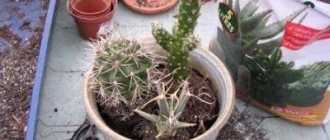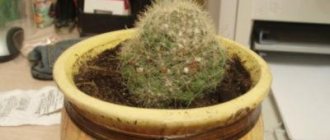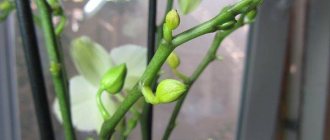Once upon a time there lived a cactus that was pleasing to the eye, but something went wrong and it began to die. I think many novice flower growers have encountered this situation. This happened to my cactus too. It migrated to me from my mother, she felt good, but I had more lighting, it gave birth to many children, its top began to grow into a ball, and at a distance of 3-4 cm from the ground it wrinkled and bent. Even though I rooted 3 children, I didn’t want to lose the cactus. The only option was to cut it above the bend and root it.
Planting methods
Cultivation when grown at home is mainly carried out by vegetative methods.
It is recommended to carry out the procedure in the spring, so that during the active growing season the seedlings quickly grow their root system and begin independent development. You can plant cactus shoots in an individual container only after rooting. However, you cannot put them in water, otherwise rot will appear instead of roots. The main difference is the seedlings' need for moist air. Specimens with spines do not tolerate waterlogging, and for epiphytes it is advisable to create greenhouse conditions for the first time.
The following planting methods exist:
- children;
- cuttings;
- seeds;
- vaccination.
Choosing a time
You may be interested in: Violet Shulamith: description of the variety and photo
How to plant cacti at home? When is the best time to do this process? Let's look at this in more detail. Cactus cuttings can be planted throughout the year. However, the spring-summer period is more suitable for carrying out this procedure. The climate in the homeland of succulents is quite hot. Therefore, it is better if the length of daylight and temperature conditions are as close as possible to native weather conditions.
Like any other plant, cacti and succulents are in a phase of active vegetative development in the warm season. This will greatly facilitate the process of rooting the culture.
You may be interested in: Violet Sagittarius Elite: description, content
How to plant a cactus cutting in autumn or winter? In this case, you must remember that the young plant must be provided with the correct temperature and light conditions.
Decorative compositions using cacti
Some people prefer to create a composition from several types of succulents, planting them in glass vases or other containers. For growing in such an “aquarium” it is customary to choose a theme:
- Desert. Open glass containers are selected. For the soil, you can use colored sand, fine river sand or a mixture of sand and pebbles. Stones and ceramic chips are used as decoration.
- Forest. Plants such as ferns, small cacti, ivy, and ficus are suitable for this composition. Leaf soil and peat with the addition of sand are used as soil.
- Mountains. For this composition, plants are selected that are native to the highlands: succulents, ivy, Saintpaulia.
How to plant cacti and other plants in glass containers? To do this you need:
- prepare the container and put on gloves;
- carefully remove the plant from the pot and rinse its roots with warm water;
- pour 1 cm thick sand onto the bottom of the container, spread expanded clay with activated carbon and other fillers in the center;
- Succulents, cacti and other plants are placed in the vase, depending on the chosen composition. The gaps between them are covered with earth, sand, gravel or crushed stone. In this case, you need to ensure that the leaves do not touch the walls of the container.
Succulents in a vase
Plants in glass containers also need to be cared for, following the following recommendations:
- lighting. It is not recommended to place the vase in direct sunlight, near radiators or other heating devices;
- temperature. The optimal temperature for growth is +22-28 degrees;
- watering. This is carried out no more than 1-2 times a week, depending on the degree of drying of the soil. The soil should be saturated with water, but at the same time moisture should not accumulate.
Important! If there is excess water, you need to tilt the container, take paper napkins and absorb excess moisture into them
Growing Decembrist
Such a beautiful flower as the Decembrist also belongs to the cactus family. It usually blooms in November-December, hence the name. How it is recommended to plant Decembrist:
- it requires a low pot with a large diameter due to the presence of an extensive root system. You can mix the soil yourself or purchase it at a special store;
- transplantation is carried out in the spring by transferring the flower into a larger pot;
- further care is very simple: water the flower with warm water, keep the room temperature at 20-25 degrees. It is not recommended to expose the flower pot to direct sunlight.
Important! It is forbidden to replant Decembrist during flowering.
Decembrist in bloom
Selecting and preparing a pot
Material
Many gardeners advise planting succulents in plastic containers , since plastic is a substance that does not absorb water and does not change the temperature of the soil placed in the pot.
Lovers of everything environmentally friendly can easily plant a succulent in a container made of clay or ceramics.
It is better if the pot is light in color so that the soil in it heats up less.
Size
Cacti grow in arid climates, so they have a long root system . Therefore, when choosing dishes, it is necessary to take into account the fact that its root system needs space, which means that cramped and small dishes will not be suitable for planting. Preference should be given to wide and deep dishes, in which the roots of the plant will feel free and will receive a sufficient amount of moisture and nutrients.
The main condition that a cactus pot must meet is the presence of drainage holes to drain excess water. Otherwise, the liquid accumulating at the bottom will cause the roots of the succulent to rot and, consequently, lead to its death.
Which cacti are best to keep at home?
A significant role of the cactus in the house is played by its appearance and shape. For example, tall columnar cacti can help when a person wants to get rid of excessive touchiness and emotional instability. Globular-shaped plants help to refrain from overeating. Cacti with finger-shaped stems are able to protect their owners from an evil tongue. In general, there is no particular reason not to keep this flower in the house. All this is quite individual: a plant that feels the love of its owners absorbs negative energy, returning only one positive energy. However, if one of the household members does not like the prickly plant, the cactus will try to “survive” him, causing him headaches or discomfort.
If, when thinking about the presence of this flower at home, you prefer a positive answer, it is advisable to place the pot on the windowsill or at the front door, most importantly, avoid placing it in the bedroom and children's room.
How to understand that pruning is needed
In some cases, the procedure is the only way to preserve an exotic plant.
Most often, pruning and re-rooting of a succulent is required:
- if rot is detected;
- in the presence of deformation of the plant, which manifests itself as a strong distortion;
- when strong growth of the cactus and its elongation are observed.
Growing in the wild in extreme temperatures has forced the plants to develop strong immunity. But when they find themselves in unusual living conditions, they become vulnerable to pathogenic flora and pests.
Warm wintering and excessively moist soil, as well as a lack of sunlight, can weaken the succulent and reduce its ability to resist parasites and pathogens.
Rotting of a cactus can occur for the following reasons:
- waterlogging of the soil;
- plant growth on unsuitable soil that retains water;
- planting in a spacious pot (leads to stagnation during watering);
- infection by pathogenic fungi and bacteria.
To prevent the spread of rotting processes, you need to trim the succulent. Without such a procedure, the cactus may die. In addition, pruning is used to correct the shape of the cactus, but only in a situation where there are no other correction options.
Other planting methods
We choose the method based on the characteristic features of each type.
From a sheet
This option is suitable for varieties with large leaf blades.
- For planting, we select material without damage. We cut it obliquely.
- Soak, getting rid of excess milky juice.
- We treat the cut with a means to enhance root growth, but this is not necessary.
- Pour drainage and soil into the planting container, install a leaf, rolled up and tied with thread.
- We insert a stick into the middle of the twist for stability. Cover with soil up to the stem.
- It will take root in a month. We create a temperature above +27 degrees, or place the container in a greenhouse.
Air layering
The method is suitable for experienced ones. It is better to use an adult plant.
- We are looking for a stem longer than half a meter. We cut the leaf at the height where we want to get layering.
- At the cut site, use a sharp knife to make a shallow cut. The juice formed during the procedure is removed.
- To admit oxygen, we put a match in it. We wrap this place with damp moss. We wrap the film on top, leaving air inside.
Important! Moss needs to be constantly moistened. Do not allow it to dry out. You will have to wait for the roots to appear within a month.
When the roots develop, cut off the shoots and plant them in a separate pot.
You will have to wait for the roots to appear within a month. When the roots develop, cut off the shoots and plant them in a separate pot.
For varieties with climbing stems, we use the method of propagation by horizontal layering.
- We choose an escape without damage.
- We clear it of leaves, make a cut with a sharp knife, and dig it into the ground.
- When the layer takes root, we plant it as a separate plant.
Handle
Cuttings are used for many ficus breeds. This method also allows you to get a new young crop from the top of an old one. Plants under two years old are not suitable for such propagation.
- To obtain a cutting, we retreat 10-15 cm from the top of the ficus. For large-leaved representatives of the species, not only the upper part, but also a piece of the stem with several leaves is suitable for use.
- We remove excess leaf plates.
- The cut must be made at an angle. After this, the juice is washed off and dried.
- The cuttings are placed in a container with water and removed for a month in a warm place prepared in advance.
- We maintain the temperature above +27 degrees. Or we make a greenhouse.
Below is a video about the propagation of ficus by cuttings using Rubber as an example:
Seeds
This method is more difficult than others.
- Material for planting is purchased at the store. The plants received at home will not grow, because they are not pollinated as in natural conditions.
- First, the seeds are treated with a fungicide to kill fungi.
- The soil and container for planting are also disinfected.
- Choose flat dishes to cover with polyethylene; be sure to make drainage holes.
- The soil is not watered before planting, but sprayed. Then the seeds are laid out.
- The temperature is maintained above + 23 degrees. Direct sunlight is dangerous.
- To ventilate, the film is lifted.
- When the sprouts appear, they are accustomed to room temperature by removing the covering.
- As soon as the leaves appear, you need to transplant the shoot into a new container. In the first months, young plants are replanted several times as they grow.
Treatment Options
Depending on the type of disease, there may be several treatment options.
Cutting off the roots
How to save a cactus if it begins to rot from below, sequence of actions:
- Cut off any roots that are severely affected or completely rotted.
- Rinse the remaining healthy roots in a solution of potassium permanganate.
- Sprinkle with sulfur powder or coal chips.
- Dry for 2-3 days, hanging in a vertical position.
- Take a new disinfected pot, pour steamed soil into it and plant the cactus.
- After planting, the plant does not need to be watered at all for 3-4 weeks.
Cutting off the roots
To avoid such a problem in the future, you must adhere to all watering rules.
Additional Information! Fungi have different modifications, but each of them will progress more strongly if the flower is in a cool room, and it is cloudy or raining outside at that time.
Re-rooting
If the root of a cactus has rotted, what to do in this case:
- Cut off the rotten piece and look carefully to ensure that the cut remains healthy and clean.
- The stem needs to be slightly “sharpened”, like a pencil, so that later it will be more convenient to plant it in the ground.
- Treat the cut with crushed activated carbon.
- Let it dry thoroughly by securing it in a vertical position or placing it on a plastic cup.
- Wait for the young roots to sprout. The process is quite lengthy and can take more than ten days.
- When the roots appear, plant the seedling in the ground for cacti.
- Water only through the tray. 10 minutes after watering, drain all the water from it.
Re-rooting process
The next time you can water only after 3-3.5 weeks.
Another way to revive a cactus if it has rotted:
- Cut off all the rotten part of the cactus.
- Dry for 3-4 days, during which time the cut should tighten.
- Treat with a root growth stimulator and place in a glass of water. You need enough water to cover the cut by 2-3 centimeters.
- After about 1-2 weeks, new roots will appear, when they reach 1 cm in length, the plant can be transplanted into new prepared soil.
A cactus transplanted in this way cannot be fed with fertilizers for one year.
Replanting a cactus
If there are pests or diseases, it is worth transplanting the flower into a new pot with new soil.
Transplanting into a new pot
The cactus is rotting from below, what to do in this case:
Shake the cactus out of the old pot, carefully examine the root and the trunk itself. Trim dried and damaged roots; if the stem is damaged, it must be cut back to healthy tissue, and the cut area should be sprinkled with crushed activated carbon. Next, the flower must be washed well in hot water (50-55 degrees), adding a fungicide or insecticide. Dry for 3-5 days in the sun in an upright position and with well-extended roots. Plant in the ground by placing the stem vertically in the pot and covering the roots with soil.
It is very important to ensure that the soil does not reach above the root collar. After such a cactus transplant, it must be kept in partial shade, without watering for about 3-5 days
After such a cactus transplant, it must be kept in partial shade, without watering, for about 3-5 days.
Note! When planting, it is important to ensure good drainage in the pot and add plenty of sand to the soil.
Trimming affected areas
How to save a cactus if it is affected by fungal rot:
- If the trunk of a cactus is affected, cut off the affected areas with a knife and treat with sulfur.
- If the top is affected, then it must be cut back to healthy tissue, and the plant itself must be used as a rootstock for grafting.
- If there is rot on the cactus, disinfect the wounds with charcoal or activated charcoal, or treat them with brilliant green.
During the period of treatment against fungi, it is necessary to exclude any spraying with water; it is better to use a fungicide solution for this purpose.
Treatment with drugs
For dry rot, brown spot and late blight, it is necessary to periodically (1-2 times a month) treat plants with phytoncides and insecticides.
With brown rot, if the cactus has become soft and watery, what to do:
- Heal all injuries on the cactus trunk.
- Adhere to the correct care regimen.
- Treat the plant with fungicides every 1-2 weeks.
Care
This aspect deserves special attention. Now that you understand how to plant cacti, it would be nice to know how to properly care for the plant at home. The first question that usually arises for novice gardeners is where to put the cactus pot. In this case, everything will depend on the type of succulent. So, cacti that grow in the desert are best placed in sunny places. Flower growers recommend providing partial shade to forest plants.
The cactus should not be watered for the first 5-7 days after planting. Simply spray the plant with water at room temperature. This will prevent it from drying out completely. Watering should start a little later. Make sure that the soil is not wet all the time; it should dry out slightly. The most optimal watering scheme is 2 times a week. Over time, the number of waterings can be reduced to once a week.
Landing instructions
You can plant a cactus without roots. To do this, take a shoot and ensure its rooting. The shoot should be chosen to be large, since it must survive for a certain time without food. If the piece is small, it will dry out before it has time to take root. Another option is possible when the baby herself moves away from the mother’s body, being ready to exist separately. If you have to separate the shoot mechanically, then you should do this with a sharp knife, and disinfect the cut site with a solution of potassium permanganate.
After the shoot is separated, it should be placed on a clean sheet of paper and placed in a cool place. The healing process will last up to two weeks. When a dry callus has formed at the cut site, this indicates that the shoot is ready for planting. If the shoots fall off on their own, you can immediately replant them.
As we have already found out, the cactus should be planted in a small pot. Next we will look in detail at how to plant cacti.
Once the soil and pot have been selected, you can plant the indoor plant. The cactus should be planted in a pot in such a way that the sprout is located on a moist substrate so that the cut point is in contact with the ground. We don’t dig in. It will take time for the shoot to take root.
To prevent intense evaporation from the soil surface, small pebbles can be placed on top. The whole time the cactus is taking root, you need to keep the soil moist. After a couple of weeks, when the shoot sprouts roots, you can care for the cactus as usual.
Propagation by cuttings is very similar to the previous case. If the cactus grows intensively in height, it may break, since this plant usually does not take root very much. Therefore, the upper part is carefully cut off. The cut area on the cactus remaining in the pot is sprinkled with activated carbon.
Sharpen the cut part as you do with pencils. Be careful not to damage the cadmium. Then take a narrow, tall glass and place your “sharpened” cactus there to dry. After a week, place moistened sand at the bottom of the glass so that there is a small space between the plant and the sand, and watch when the top sprouts roots. Now you can place your pet in a potty.
Many people are interested in how to plant a cactus with seeds. This process has a number of subtleties. First, the seeds are germinated in plastic trays. When preparing the container, make holes in the bottom. Place drainage gravel at the bottom. Use a mixture of sand and earth as soil. Before planting, the soil should be lightly watered. Now make grooves and use a toothpick to plant the seeds. Constantly moisten the surface so that the seeds germinate better. The sprouts will appear at different times. Early seedlings should be taken for planting in a pot. As soon as the thorns begin to appear, the sprouts swoop down and provide a “residence” in a separate pot. During the first year, this procedure is performed every two months.
This should be done extremely carefully so as not to damage the roots. The plant, together with the earthen lump, is transferred to a new pot.
Picking cacti or replanting them
After the seedlings have formed roots, it is necessary to transfer them to a deeper general container for further development. Healthy plants do not need to shorten the root system
It is important to plant the cactus correctly, since even a slight bend in the root can cause rotting. For this reason, non-standard ways of carrying out the procedure have been invented.
Picking cacti step by step:
- Place a drainage layer about 1 cm thick into a clean, disinfected container.
- Cover the top with a small amount of soil mixture.
- Place the container at an angle of about 30° so that the substrate does not crumble, but the seedlings can be placed on their side.
- Cover one wall with soil, lay a row of seedlings, taking into account further increase in size.
- Place the root collar on the soil surface and straighten the roots.
- Gently sprinkle the seedlings with soil mixture on the other side. Lay out the 2nd row and subsequent ones in the same way.
When transplanted by placing them on a hill, cacti often do not occupy a vertical position, so after filling the container, you need to straighten the seedlings using tweezers. Lightly compact the soil by tapping the edges of the container. Pour a small layer of river sand and allow the substrate to settle again.
There are several ways to plant a cactus at home. The absence of roots does not make the operation impossible, since the plant takes root well if basic agrotechnical recommendations are followed. Sowing seeds is also sometimes required, since over time the crop loses its decorative properties and becomes more susceptible to the effects of adverse environmental factors.
Choosing a sprout
How to plant cactus children? What you need to know about choosing shoots? Let's look at this in more detail. Before carrying out this procedure, it is extremely important to properly prepare the process. “Children” are formed on the cactus itself. They can be located both in the upper part of the plant and at the very roots. They are separated from the mother plant very simply, since they are practically not connected to the stem. The shoots of many types of succulents begin to produce roots while still on the adult plant. Over time, they may even fall off and fall to the ground, moving on to further development of the root system. Plant propagation occurs without any problems. When choosing a shoot for transplantation, you should definitely pay attention to its size: the larger it is, the better. Also take into account such an important point as the location of the process. According to experienced flower growers, better shoots are located closer to the top.
For planting cacti, you can also use “babies” without roots. This won't cause much difficulty. It is advisable to place the shoot in a dark, cool place for 3-7 days so that the cut dries out a little. This is done to prevent rotting.
How to grow a cactus from seeds
Of course, growing a young cactus using cuttings is not difficult if you do everything correctly. Another thing is the seed method. However, nothing is impossible for amateur gardeners. Therefore, it would not be a bad idea to try growing the plant in this way.
True, you should know that in this case, firstly, there will be more fuss than with children, and secondly, you will have to take some precautions
First you need to take care of your “working tools”. We are talking about a container in which the seeds will be placed. It must be well treated with manganese solution or steam. The substrate, which is kept in the oven for about forty minutes before use, is not left without attention. After this, you can begin the process itself.
It comes down to these points:
- The soil should be thoroughly wetted and leveled.
- After this, make tiny holes, at a distance of a couple of centimeters from each other.
- If the planting material is large, then it is lightly sprinkled with substrate on top, if it is small, then everything remains that way.
- The container with seeds is covered with glass or tightly closed with film. After this, the container will need to be taken to a dark place, but with mandatory access to air.
Usually seeds germinate in 2-4 weeks. From this moment you can start removing the film or moving the glass away. It would not be a bad idea to take the container with the young animals into a bright room, but under no circumstances place it in direct sunlight. You can remove the film only after spines appear on the plant.
It must be said that young plants should not be forgotten to water, because they will dry out instantly. At the same time, you should ensure that the soil is not wet, otherwise all the seedlings will rot. It will be possible to plant the cactus when it is already more or less stronger. More details about this are written below.
Types of cacti
Let's look at this in more detail. The most popular types of cacti, photos and names of which can be found on resources of interest:
Astrophytum: grows quite well. A distinctive feature of the culture is the presence of white flakes on the outside of the ribs. When flowering, beautiful yellow inflorescences are formed. Ferocactus: has hard, long spines. Usually this type of cacti has a cylindrical shape. It can reach 5-6 inches in height. “Children” often appear near the main trunk. In summer, large flowers may appear on adult specimens. Prickly pear: this type of cactus is characterized by its unpretentiousness and rapid growth
It is important to use gloves when caring for this plant, as it has very sharp spines. The peculiarity of this cactus is the presence of tiny spiny bristles throughout the stem.
They can cause much more inconvenience than the needles themselves, since they are very difficult to notice. There are different varieties of prickly pear: flat, oval, and so on. These cacti are characterized by their large size. They bloom unusually spectacularly. They bear edible pear-shaped fruits. The plants are quite hardy and can be planted even in open ground. Echinocereus: small spherical cacti covered with short spines. They bloom quite often with beautiful inflorescences. Caring for this type of cacti is very easy, so it is often recommended for beginners.
How to properly prepare the soil for a cactus shoot?
In nature, cacti live in aggressive environmental conditions; their root system is located in sand mixed with soil. Therefore, in home breeding, the composition of the soil must be taken care of in advance.
You can prepare the soil for succulents yourself. The main layer of soil is prepared from soil, dry leaves and coarse sand. The soil can be taken from a deciduous forest; it is ideal in composition for cacti. Dry leaves should be chopped. Sometimes foam balls are added to the soil to make the soil more porous, which is what succulents like.
All ingredients are mixed and prepared, and then placed in a pot on a drainage pre-laid on the bottom. Moreover, the latter should occupy about a third of the pots. Drainage can be prepared from crushed crushed stone, expanded clay or finely chopped wine corks.











